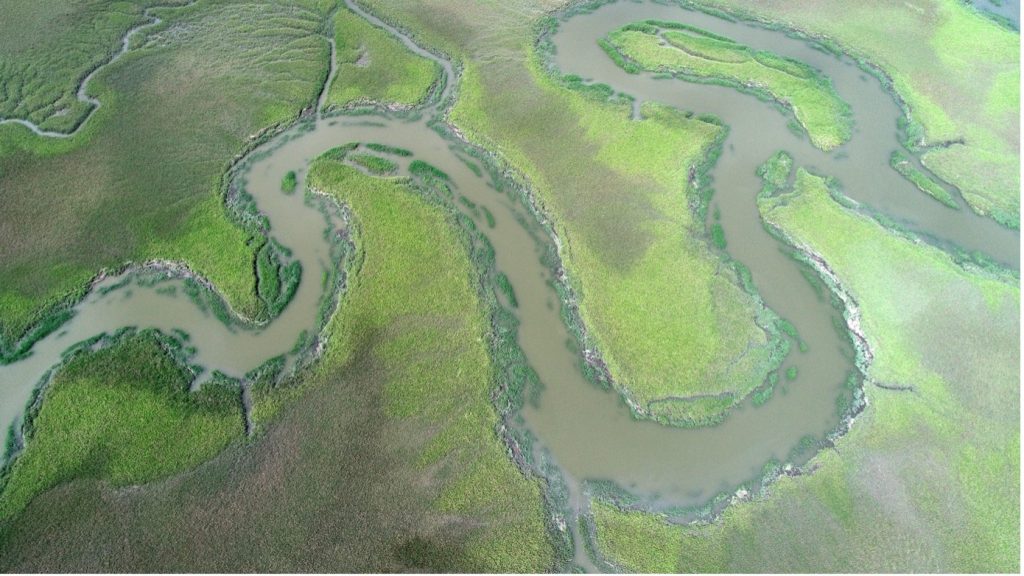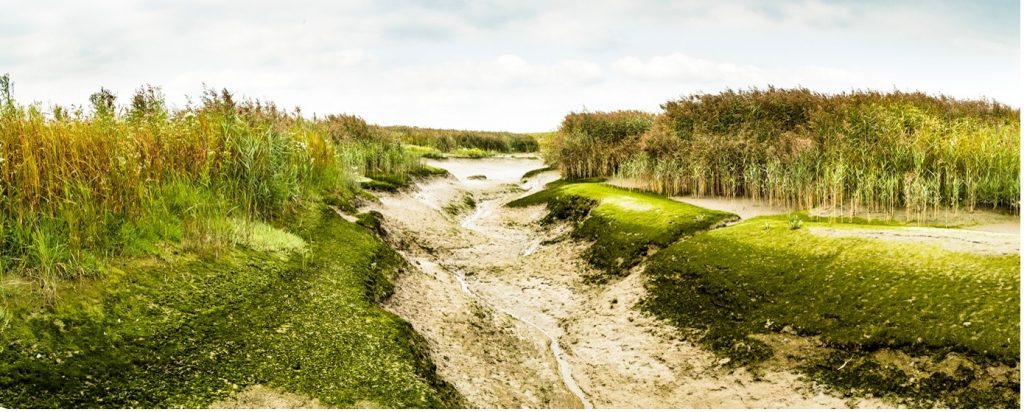Peat bogs, salt marshes, mangrove forests and seagrass meadows cover only 1 percent of the Earth’s total surface but sequester more than 20 percent of all the CO2 absorbed by ecosystems worldwide. This unique property arises because plants build these wet landscapes. Through such landscape-forming processes, an enormous amount of CO2 is captured and stored in the soil. The power of such feedbacks in creating ‘carbon capture hotspots’ is demonstrated in a study published just days ago in the journal Science by a team of Dutch, American and German scientists.

Hotspots of CO2 storage

In their study, the team shows that oceans and forests retain the most CO2 globally, followed by wetlands. “But when we look at the amount of CO2 stored per square meter, it turns out that coastal wetlands, seagrasses, and peatlands store about five times more CO2 than forests and as much as 500 times more than oceans,” says study co-author Christine Angelini, Ph.D., the director of the Center for Coastal Solutions at the University of Florida and a professor in the Engineering School of Sustainable Infrastructure & Environment (ESSIE). “These systems are the superstars of CO2 capture and storage.”
Landscape-forming plants
In comparing how these different carbon-capture hotspots work, the team pulled together compelling evidence that they are all are built by landscape-forming plants that help each other when they grow close together; a process that also drives CO2 capture and soil formation.
In raised bogs that are found in Canada, Siberia, Germany and other cooler, wet places, peat mosses behave like sponges that retain a considerable amount of rainwater, driving their own growth. Underneath a veneer of living peat mosses are the remains of dead peat mosses that accumulate over decades to centuries. Because this layer —which can be up to 10 meters thick — is permanently under water, these dead, carbon-rich remains hardly decompose. This means that considerable amount of carbon is captured as the mosses gradually build up peatland landscapes.
In lowlands and coastal marshes found along temperate and tropical shorelines around the world, plants retain suspended sediments and dead plant material with their aboveground stems and leaves and belowground roots. Nutrients are released from this captured debris, fueling additional plant growth and the formation of soil chock full of carbon. Just like in raised bogs, this positive feedback between debris capture and plant growth thickens a carbon-rich soil layer, building complex landforms in the process. “Scientists have long appreciated that these feedbacks are important to the formation and growth of wetland and peatland ecosystems” says Dr. Angelini, “but what makes this study stand apart is that we show that these feedbacks are the common denominator across the world’s most powerful carbon-capture hotspots.”
Restoring wetlands to slow climate change
Because wetlands are essential in the fight against climate change, it is alarming that human activities are causing the loss of 1 percent of these ecosystems per year worldwide. Land reclamation, pollution and shifts in water levels and flows are widely breaking down plant growth-soil formation feedbacks. “Once disturbed, these wetlands and peatlands release enormous amounts of CO2 from their soils, accounting for about 5% of global CO2 emissions annually,” says study first author Ralph Temmink, a professor at Utretch University in the Netherlands. “When wetlands are drained to provide space for farmland or development, hundreds, even thousands, of years of carbon stored in their soils can become exposed to air which stimulates decomposition and the release of greenhouse gases.” Adding to this, Dr. Brian Silliman, a marine conservation ecologist from Duke University and co-author of the work says, “The result is an invisible, reverse waterfall of CO2 draining into the atmosphere. When we disturb these ecosystems, they switch from powerful carbon sinks to potent CO2 sources.”
Conserving and restoring wetlands are therefore key actions to counteract climate change, the study emphasizes.

The good news is that although more than 50 percent of wetland restoration efforts have failed historically because landscape-forming processes were insufficiently accounted for, coauthor Tjisse van der Heide, Ph.D., a professor of coastal ecology at the University of Groningen says, “We now know that restoration is much more successful when the plants are placed in large dense clumps, when their landscape-forming properties are mimicked, or simply when very large areas are restored in one go. With this knowledge, large-scale restoration of these important wetlands is now within reach.” The study thus concludes that wetland restoration should now be viewed as a relatively reliable, cost-effective and self-sustaining strategy to counteract rising atmospheric CO2 concentrations and global warming.
Florida, Where Wetlands and Wetland Science Rule
Reflecting on the local relevance of the study, Dr. Angelini highlighted that “Florida is among the most wetlands-rich states in the nation, second only to Alaska. We have extensive freshwater wetlands throughout the interior of our state and salt marshes, mangrove forests and seagrasses that define our state’s 8,000 miles of coastline. These are the powerhouses of CO2 capture and carbon storage that we focus on in this study.” However, to capitalize on this valuable service, Dr. Angelini stresses that investments to conserve, restorie and reclaim Florida’s wetlands are needed, efforts that have high potential achieve knock-on benefits to water quality, biodiversity and ultimately the quality of life for our citizens.
“Fortunately,” Dr. Angelini says, “the University of Florida is the birthplace of Ecological Engineering that has long focused on creating wetlands to regain their services and remains a global leader in wetland and coastal science.” Looking ahead, Dr. Angelini says, “A core research pillar pursued by the Center for Coastal Solutions with our partners from the Netherlands, the Duke University Restore Program, The Nature Conservancy and others is to understand how to successfully supersize coastal wetland restoration efforts through programs such as the US Army Corp’s Engineering with Nature Initiative.”
This international team hopes such work will ensure that wetlands and peatlands are a central component of local, region and global strategies to counteract climate change.
Details of the publication
Recovering wetland biogeomorphic feedbacks to restore the world’s biotic carbon hotspots
Ralph J.M. Temmink, Leon P.M. Lamers, Christine Angelini, Tjeerd J. Bouma, Christian Fritz, Johan van de Koppel, Robin Lexmond, Max Rietkerk, Brian R. Silliman, Hans Joosten, Tjisse van der Heide
Science, 2022
https://www.science.org/doi/10.1126/science.abn1479